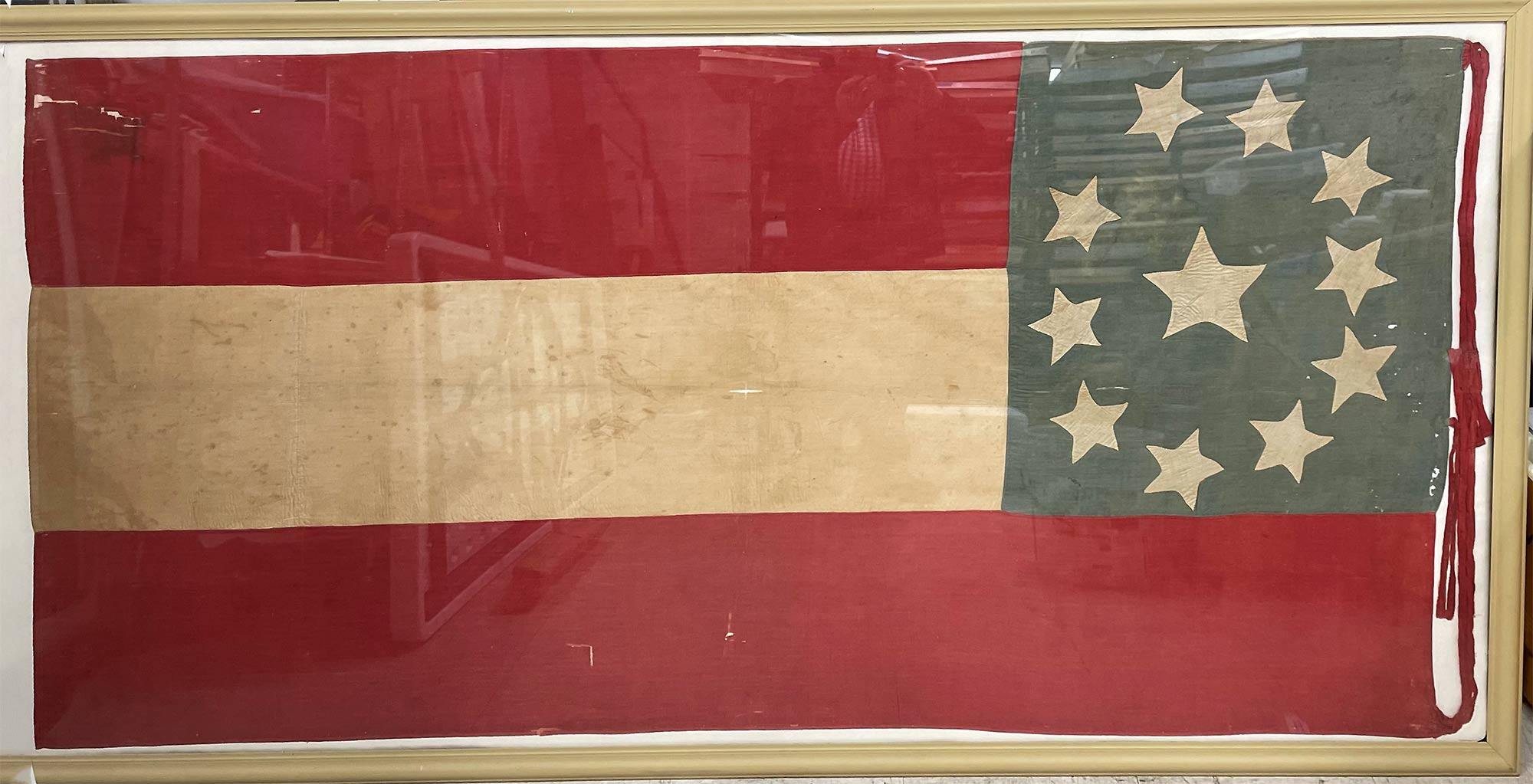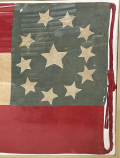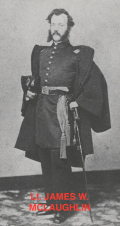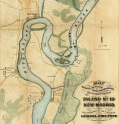site search
online catalog
CONFEDERATE FIRST NATIONAL FLAG FROM ISLAND NUMBER TEN

$40,000.00
Quantity Available: 1
Item Code: 1179-004
This Confederate First National flag has a tight provenance going back to 1935, and before that an oral history as a war souvenir brought back from Island Number Ten by James William McLaughlin, a prominent Cincinnati architect who in 1861 had served as a lieutenant in the “Benton Cadets,” the infantry of General Fremont’s “Body Guard,” and by the time of the campaign against Island Number 10 in March and April 1862 was a “special artist” for Frank Leslie’s Illustrated Newspaper, which published woodcut illustrations based on McLaughlin’s sketches made on location during the campaign. These were credited to him at the time and also when republished in 1893 in Leslie’s The Soldier in Our Civil War. Some of McLaughlin’s original drawings of the campaign survive in collections, including the Becker Collection at Boston College. Some of his papers are at the Cincinnati Art Museum.
The flag is accompanied by an extensive research file that includes a letter from renowned vexillologist Howard Madaus, 1989 conservation reports, and correspondence at the time of its 1975 sale by George E. Linton of Brooklyn, NY, to R.B. O’Connor of “Rebel Relics,” Richmond, Va. The identification of McLaughlin and its capture location, however, are documented at least back to 1935: according to a 2 June 1975 letter by Linton he purchased it in 1935 “from the estate of a Mr. Willis,” likely also a resident of Brooklyn or surroundings. Although referring to Willis’s “estate,” Linton indicates Willis was still alive at the time and supplied him with McLaughlin’s name, the fact he had served in the Benton Cadets, and that the flag came from Island Number 10. A 1936 letter in the research file addressed to Linton in Brooklyn from the War Department responds to his inquiries about McLaughlin, confirming Linton was in possession of the information by that date at least. We have not learned more about Willis, though Linton asserts he had been on the Cornell Football team in 1901, and do not have a firm connection between him and McLaughlin, but we note that McLaughlin lived until 1923 and when his widow died in 1928, one of their sons and three of their daughters were living in New York City, making it likely Willis got the flag and owner’s identification directly from a family member.
The flag itself is a Confederate First National color measuring 34 ½ inches on the leading edge and 72 ¾ inches on the fly, made of cotton materials according to the 1988 report by Textile Preservation Associates, and poplin, a mix of silk and cotton, according to Madaus, and has three sets of ties. The condition is good, with a few old tears that were darned closed, some other narrow tears, and a little loss on the upper portion of the fly. Interested parties can consult copies of the conservation treatment report. As professionally conserved, mounted and framed it now measures 41 by 81 inches. The pattern is the standard three stripes, red-white-red, and a blue canton with ten 4-inch white stars in a circle around a single 6-inch white star at the center. The eleven stars were officially adopted in July 1861 after the secession of Tennessee and the flag omits the late 1861 addition of stars for the contested states of Missouri and Kentucky, all of which is somewhat fitting since the campaign against Island Number Ten took place in those three states. These eleven stars are in place on the reverse of the flag only, the incomplete obverse seems a sign of haste in construction rather than intention to display only one side: the TPA conservation report states, “the condition and wear indicate the flag was attached to a vertical staff and flown for a period of time.” Madaus’s letter indicates it belonged to an infantry unit, likely from Louisiana, though he does not give a reason for that state attribution. A helpful correspondent has noted the presence of the 11th and 12th Louisiana Regiments, the 5th Louisiana Battalion, and Pointe Coupee Louisiana Battery, and that the 12th Louisiana had been sent to Ft. Pillow, leaving the others as possible candidates.
Overshadowed by the Battle of Shiloh, fought just as federal forces clinched the victory at Island Number Ten by capturing the island, the larger defense network around it, and most of the forces manning it, the campaign, siege and fighting, nevertheless opened part of the Mississippi and elevated General Pope to a prominence he was unable to maintain as commander of the Army of Virginia later that year. Confederates had erected batteries along the shores of the Mississippi where it formed a double loop on its way south, turning first clockwise to flow north and then counterclockwise to turn south again somewhat west of its original course. Island Number Ten was at the bottom of the first loop and mounted some 17 guns in five batteries plus another 9 in a floating battery moored at the island’s west end. To the east of the island and to its rear, along the shore eastern shore of the river as it entered the first bend, additional batteries totalling 24 guns covered the river. To the north, at the top of the second bend was the city of New Madrid with another 21 guns mounted in two forts, and in the renewed southern course of the river, Confederate gunboats added to the defense, with another battery on the eastern bank. Defenders totaled about 7,000, posted in the various batteries and fortifications.
Pope, in command of the Army of the Mississippi, arrived unexpectedly in early March, approaching New Madrid from the west with about 10,000 troops, increased to about 23,000 by the end of the campaign. He first took Point Pleasant, below New Madrid, on the western shore of the river as it renewed its southern course, allowing him to harass Confederates on the other side with artillery fire, and then moved against New Madrid and its forts, which were evacuated on the night of March 13. A siege concentrating on Island Number Ten then ensued until April 4 with bombardment from the Western Gunboat Flotilla, which had come down the Mississippi to a point just above the island, and eventually got two gunboats past the island and down to a point where they could counter Confederate gunboats south of New Madrid and allow Pope to push across the river. This essentially cut off Island Number Ten and Confederate forces to the north, who could not move east because of the swampy terrain, and forced their surrender when Pope reached Tiptonville first, along their sole escape route. Estimates of the number surrendered there vary from 4,500 to 7,000. McLaughlin’s sketch of the surrender, as printed in Leslie’s, was captioned, “Surrender of the Confederate Forces, five thousand strong, under Generals McCall and Gantt, to General Paine, at Tiptonville, Tenn., April 8th 1862. After their retreat from Island No. 10, as described on page 257. From a sketch by J. McLaughlin.”
Linton’s 2 June 1975 letter provides some additional information he got from Willis that sounds like Willis had gone back to his source in the family: “Mr. Willis did learn more about the flag and relayed his findings to me. He said the flag was in the battle and flew over the Citadel which was in the Fort.” At best this is second-hand from the family as they remembered the story and envisions Island Number Ten as a single large fort. We note the presence of an enclosed redoubt on the shore east of the island, but references to “the Fort” and “the Citadel” would seem to be guesses by the family or Linton. Similarly, Linton says that McLaughlin reenlisted after his service in the Benton Cadets, though he admits there is no record of it, which is clearly an effort to reconcile the history of the flag with what he knew about McLaughlin: only that he enlisted as 1st Lieutenant of Capt. Gilbert’s Company C of the Benton Cadets on 16 September 1861 and tendered his resignation on December 7, which was accepted on December 10. Linton hedges a bit in how McLaughlin obtained the flag, noting in a letter of 28 June 1975 only that McLaughlin “had charge of this flag at Battle of Island Number 10 in 1862.”
We can fill in McLaughlin’s history and the background of the flag from several biographies of prominent Ohioans. Born in 1834, McLaughlin studied architecture with a prominent Cincinnati architect, opened his own firm about 1855, and had already designed several civic structures by the time the war started. That career would have developed his talents as a draughtsman, but he was also a member of the Cincinnati Artists’ Sketch Club. He officially enlisted at St. Louis, where Fremont had his headquarters, but Company C was one of several recruited in Ohio and drew men from the Cincinnati area. They were part of the infantry in “Fremont’s Body Guard,” and were also designated the Benton Cadets, and sometimes talked of as a training cadre for future officers in Fremont’s forces. McLaughlin had enough time after enlisting to have his photograph taken in full uniform with his dark overcoat thrown back to show his line officer’s frock coat, sword, sword belt, sash, and an infantry officer’s forage cap cradled in the crook of one arm. He was thus in Fremont’s forces in time for the advance against Confederates in Missouri on October 7 and the Battle of Springfield on October 25, where the cavalry of Fremont’s bodyguard routed Confederate defenders.
McLaughlin’s military career was cut short by Fremont’s replacement by General Hunter in November. In addition to whatever disappointment they felt, many of his officers and men had been recruited on Fremont’s own authority, calling for a reorganization and Ohio, for one, had its eye on troops recruited within its borders, so the writing was on the wall. Some officers resigned in hopes of an Ohio commission. McLaughlin’s letter of resignation, penned at Rolla, MO, on 7 December 1861, indicates the regiment was understrength and he desired to transfer into the Engineer Corps. Three months later we find him with Pope. Whether he had any subsequent service as a civilian employee in a military engineering department is not mentioned in the biographies we consulted, but his papers exist in some institutions, which might clarify that part of his record, but he was clearly with Pope at Island Number Ten in his capacity as “special artist” for Leslie’s, an occupation that is mentioned in some of his published biographies.
McLaughlin was with Pope fairly early in the campaign and there to the end, giving him plenty of opportunity to secure the flag. The Becker Collection contains his sketch of one of the captured forts at New Madrid, with his notation: "These barracks are adjoining Fort Jeff Thompson are built in a very neat and substantial manner of sawed boards // Rebel cantonment at New Madrid [deserted by Jeff Thompson- crossed out] now occupied by 1st Reg. Infantry & 7th Wisconsin battery // These sketches as you perceive are taken very hurriedly as I leave with the advance of Gen. Pope's command which crosses the river at 6 P.M. yours truly Jas W. McLaughlin." Further, not only do we have the woodcut from his drawing of the surrender at Tiptonville, the Becker Collection also contains an original sketch captioned, "Landing of Gen. Pope's army on the Kentucky shore opposite New Madrid April 7th. // Large guns & howitzers in the foreground dismounted by the fire of the gun boats a few hours previous. // Jas W. McLaughlin // Del." (The last is Latin, indicating the artist.)
McLaughlin’s postwar career was strictly in the field of architecture, where he gained some fame. He seems to have lived entirely in the Cincinnati area though, as mentioned, several of his children ended up in New York City. Many of the family papers are at the Cincinnati Art Museum, including those of his sister, Mary Louise McLaughlin, a ceramic painter well known to collectors of Rookwood pottery. [sr] [PH:ss]
EXTRA SHIPPING REQUIRED.
~~~~~~~~~~~~~~~~~~~~~~~~~~~~~~~~~~~
THIS ITEM, AS WITH ALL OTHER ITEMS AVAILABLE ON OUR WEB SITE,
MAY BE PURCHASED THROUGH OUR LAYAWAY PROGRAM.
CLICK HERE FOR OUR POLICIES AND TERMS.
THANK YOU!
Inquire About CONFEDERATE FIRST NATIONAL FLAG FROM ISLAND NUMBER TEN
For inquiries, please email us at [email protected]
Most Popular
Historical Firearms Stolen From The National Civil War Museum In Harrisburg, Pa »
Theft From Gravesite Of Gen. John Reynolds »
Selection Of Unframed Prints By Don Troiani »
Fine Condition Brass Infantry Bugle Insignia »
British Imported, Confederate Used Bayonet »
Scarce New Model 1865 Sharps Still In Percussion Near Factory New »
featured item
CIVIL WAR COMMERCIAL FORAGE CAP WITH MAINE BUTTONS AND ASSOCIATED INSIGNIA
Commercial caps were simply those purchased privately rather the issued by the government. They might more or less closely follow contract patterns with the purchaser able to suit his taste and wallet, though an enlisted man, seeking something nicer… (1052-139). Learn More »
site search
Upcoming Events
May 16 - 18: N-SSA Spring Nationals, Fort Shenandoah, Winchester, VA Learn More »








